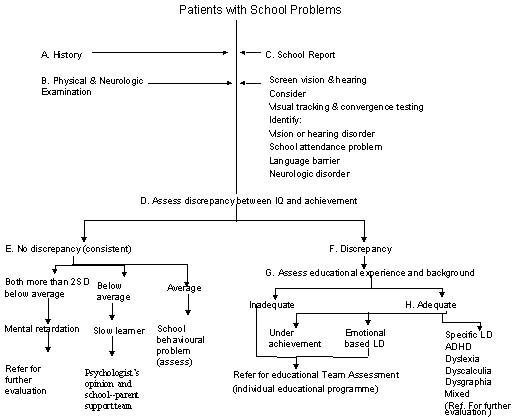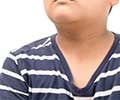
Office assessment
The office assessment of children with school problems include the following steps: (Refer algorithm)
A. History :
-
Maternal drug/alcohol intake/perinatal insult
-
Childhood development with particular attention to speech and language.
-
Problems of growth and nutrition.
-
Sleep disorders problems of toilet training
-
History of chronic illness, frequent hospitalization, any evaluations or therapies.
-
Health problems related to learning such as seizures, recurrent or persistent otitis media, lead poisoning or iron deficiency anaemia.
-
Complete description of the child’s behaviour and learning since early infancy.
Family history of learning disabilities, school failures, mental illness, behavioral problems and substance abuse. -
Discordant family, emotional disturbance in the parents and other family members
B. Physical examination:
-
Evaluate the child’s overall well-being, alertness, cooperation and ability to communicate.
-
Record standard measurements of height, weight, and head circumference
-
Note any dysmorphism, neurologic deficits or any genetic syndromes.
-
Elicit soft neurological signs such as confusions of left and right. Inability to perform rapid alternating movements and hand and fingers, having choreiform movements in outstretched hands , difficulty in tandem walking (positive in ADHD)
-
Look for coordination problems
-
Do vision and hearing tests to rule out sensory deficits
C. Obtain direct information on the following areas:
a. Intelligence - A simple IQ (intelligence quotient) testing can be done using Leiter Intelligence Scale and intelligence graded (See Appendix-1).
b. Achievement - A report on the academic achievement is obtained from the Class
Teacher or by reviewing the report card.
c. Attention/concentration/hyperactivity - A descriptive report on these three areas is obtained from the Teacher.
d. Perceptual (visual/motor) function - A report on any sensory testing is obtained.
e. Behaviour – A descriptive report of the behaviour of the student is obtained from the teacher.
D. Compare IQ and standard scores of achievements : Note the presence or absence of discrepancy between the two.
E. No discrepancy : IQ is consistent with the achievement. Under this category we can further evaluate as follows:
i) IQ consistent with achievement but both are more than 2 standard deviation below the average (IQ < 69). This indicates mental retardation.
ii) IQ is consistent with achievement, but they are just below average (IQ 70-89). This categorizes the slow learners.
iii) If they have average IQ and achievement (IQ 80-109) - investigate for behavioural problems.
F. Discrepancy present : A significant discrepancy between IQ and achievement definitely indicates a learning disability (specific or general).
G. Assessment for educational experience and background: The above category (F) is assessed for educational experience and background. It has been estimated that 20% of children who are below average with discrepancy in IQ and academic achievement when enquired about educational history reveal major gaps in the education, frequent change of schools and other disruptive experiences. Hence if present needs change in the educational programme.
H. When educational history and experience are adequate, but there is a discrepancy between IQ and achievement, it could either be a specific (dyslexia, dyscalculia, dysgraphia, ADHD) or general (genetic or neurologic) learning disability or may be secondary to emotional or psychiatric illness or could just be an underachievement due to lack of motivation.
Laboratory investigations
Indicated only if physical examination or history suggests a medical condition such as iron deficiency, lead poisoning, or thyroid disorder.
|
Summary School health problems are a major challenge to Family Physicians The role of Family Physician is to identify and treat medical causes of school problems. Note: This chapter deals only with the gross identification of school problems and the importantce of referral for psychological assessment and further interrogation into the depth of problems. Subsequent chapter will give in detail the approach |




Comments
Please check on the references of the above statements. Most of it is not correct.